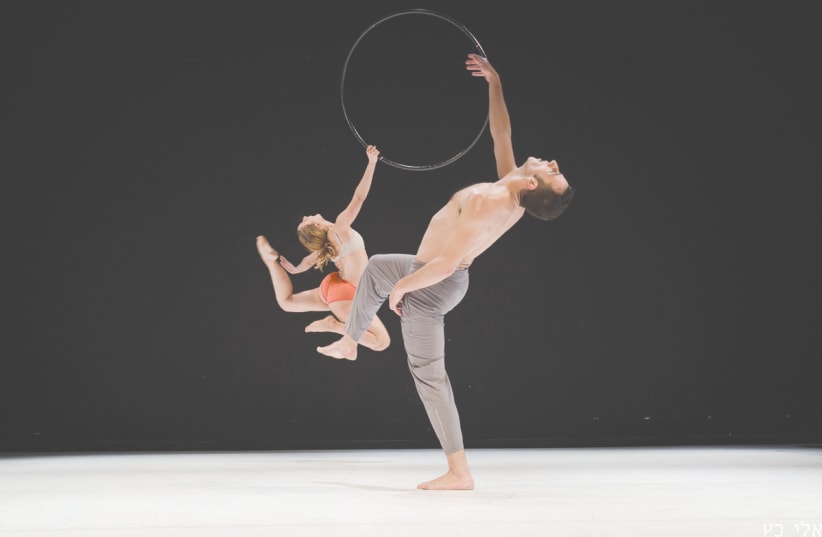Ronit Ziv isn’t your typical choreographer. In fact, she isn’t your typical anything. She is edgy, provocative, insightful, sharp and unpredictable and so are her choreographies. Her attitude and aesthetic have placed in her a league of her own in the Israeli dance community, for the good and the bad. She stands out.
She has presented work extensively throughout the country and abroad, has been the artistic director for prestigious festivals and has recently returned from a sought-after Visiting Israeli Artist Fellowship in California. Over the years, Ziv has ruffled feathers in her community, both on stage and off, and has been at the heart of a controversy or two. Her body of work includes “Woman (A) Woman (B),” “Botz,” “Deconstruction and Reconstruction” and “Three Sisters.” This week, Ziv will throw herself a 20th anniversary performance/party at the Suzanne Dellal Center to honor her two-decade tenure as a choreographer. The performance, entitled “hahaha.dot.com”, was created in 2018 and already won first place at the Beersheba Fringe Festival.
Ziv began dancing at a young age and admits that becoming a choreographer saved her from her space cadet nature. “I was a very funny and irresponsible child,” she laughs over the phone. Ziv’s chuckle is self-deprecating and loose at once. “There was something more daydreamy about me as a kid. I was experiential. I happened to be in Paris at the Pompidou Center and there was a dance film festival. I saw it and decided that it was what I wanted to do. I didn’t need anyone to explain it to me, I understood it.”
“I knew I wanted to be a choreographer but it didn’t go easily,” she said. “I couldn’t daydream. I had to meet deadlines. I had to be precise to get the piece to look exactly as I wanted it to. If that meant not sleeping or eating, getting the right costume, getting the dancers to really execute the movement as I wanted or getting the sound to be exactly as I thought it should sound... I couldn’t leave it until it did. I made my first piece when I was studying at the Seminar (Hakibbutzim). Suddenly from being that dreamy child, choreographing made me a serious person.”
Already with her first work, “Rose Can’t Wait,” Ziv plunged her stake into the fertile ground of Israel’s dance community in the late 1990s. She won the 1999 Shades of Dance Choreography Competition as well as The Jerusalem Academy of Music and Dance’s Choreography Competition. The work was then invited to participate in the Pina Bausch Festival in Wuppertal, Germany.
IN THE 20 years since unveiling that first signature work, Ziv has played around with many themes, approaches and concepts in her choreographies. Her path was in no way paved with opportunity. Ziv had to fight and fund-raise and pep-talk herself many times over the years. Her career had ups and downs, dry spells and magical floods.
“Every time I say, ‘Enough! It’s hard. How much can I do it?’ And then I leave making dance and I miss it,” she said. “I feel that in the studio, I understand. I understand how to do it. It doesn’t matter if people like or dislike it. It’s my identity. Sometimes to release and go back to it makes for the strongest work. It allows the development within it.”
The foundation of Ziv’s work is always movement, specifically the release technique, but Ziv has explored text, live music and various set and costume elements to bolster her vision.
“My relationship with dance is always changing and meeting me at different places,” she explains. “If I try to recreate the last experience, I will get stuck in one spot. No piece is like the first and when I tried to get onto the same theme, it didn’t work. Each time, I do something a little different or a lot different. There were pieces in which I used text or another artist or video.”
Having returned from a semester of teaching in Claremont, California, Ziv found that the Tel Aviv dance scene had continued to gallop forward and she had to hit the ground running to make up for lost time.
“I had to start everything from scratch again,” she said. “It was fun, fun, fun being there but getting back presented some challenges.” She took comfort in returning to the studio, getting the wheels churning on “hahaha.dot.com.”
“It was a very summer process,” Ziv said. “It was hot, we were working in south Tel Aviv. We had a lot of rehearsals on Salome Street. I had two great dancers, Liron Kichler and Eldar Elgrably, who are wonderful performers. We worked a lot with text. I feel very connected to words. I brought a lot of texts, poems and songs. I am working with Uri Rubinstein, who is the lighting designer, but also really helped me to come up with the set, which includes piles of newspapers and magazines and grass. There is live music,” she adds, with excitement lifting her voice.
With Ziv’s tenacity and dedication, we can expect to see another two decades of dance from her. “I wish for myself that I will continue to dance for another 20 years,” she said. “It’s important for me to stay relevant. I don’t want to make work just for myself. I want to create within a community. I hope that dance will continue to be in dialogue with what happens around us, justice or injustice and that I will find the places to put reality into my dance. I want to keep exploring how I can dance my thoughts, my anger and what is happening around me.”
Ziv will present “hahaha.dot.com” in the Zehava and Jack Dellal Studio at the Suzanne Dellal Center on July 25 at 9 p.m. For more information, visit www.suzannedellal.org.il.
